|
|
 发表于 10-5-2008 11:49 AM
|
显示全部楼层
发表于 10-5-2008 11:49 AM
|
显示全部楼层
During Terminal Countdown Demonstration Test(TCDT)
STS-124 Crew:
Mark E. Kelly - Commander
Kenneth Ham- Pilot
Karen L. Nyberg- Mission Specialist 1
Ronald J. Garan, Jr- Mission Specialist 2
Michael E. Fossum- Mission Specialist 3
Akihiko Hoshide- Mission Specialist 4
Gregory Chamitoff
- Expedition 17 Flight Engineer
http://mediaarchive.ksc.nasa.gov/search.cfm?cat=4
Photo Galleries
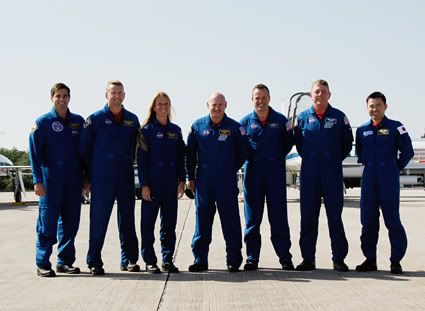
arrival at NASA Kennedy Space Center's Shuttle Landing Facility, thecrew of space shuttle Discovery's STS-124 mission gather for a groupphoto. The crew is at Kennedy to take part in the Terminal CountdownDemonstration Test, or TCDT.
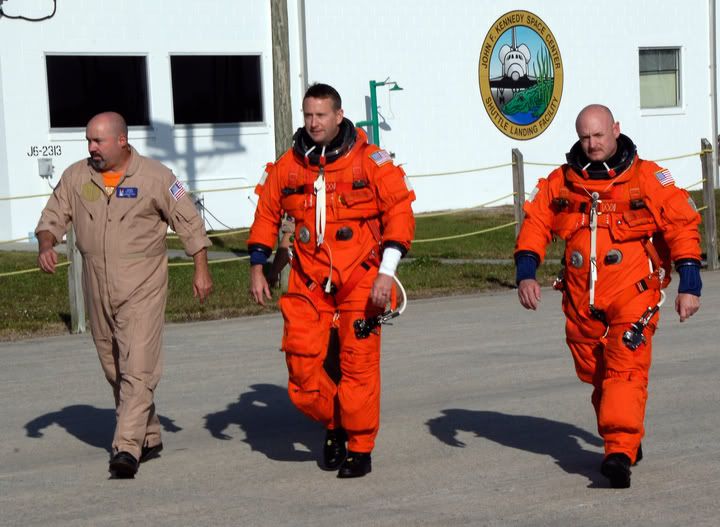
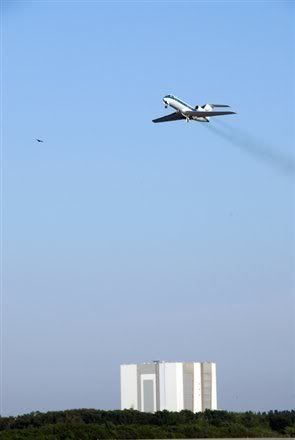
STS-124 Pilot Ken Ham and Commander Mark Kelly headfor the runway to practice space shuttle landings using NASA's ShuttleTraining Aircraft, or STA.
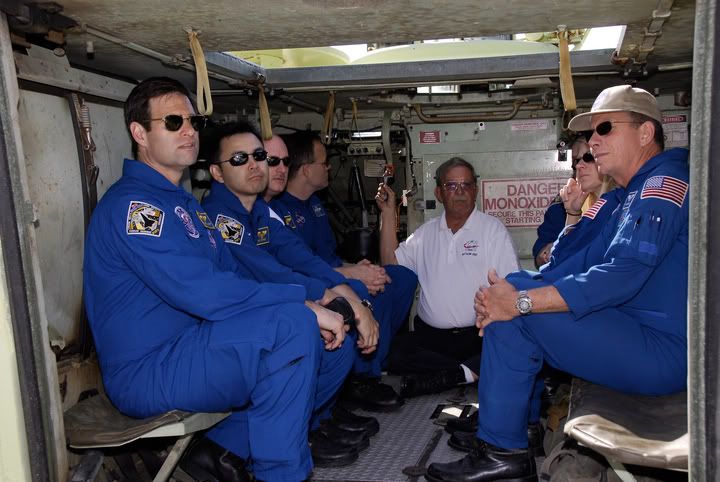
crew members get instructions inside an M113 armored personnel carrier about emergency procedures.
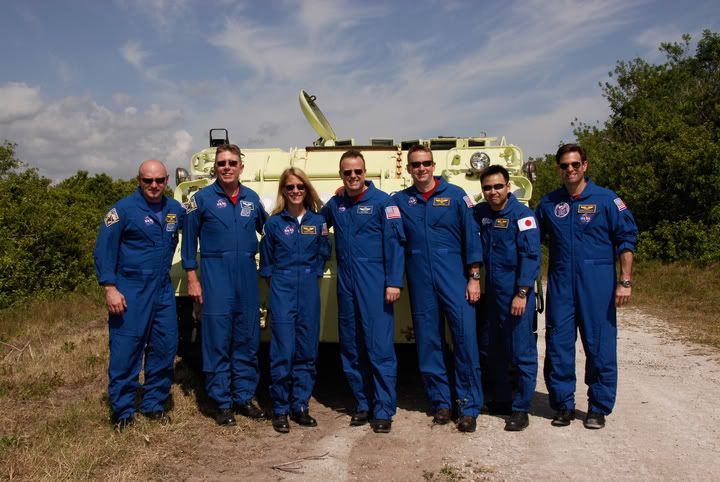
completing M113 driving practice, the STS-124 crew stands in front of the armored personnel carrier for a photo
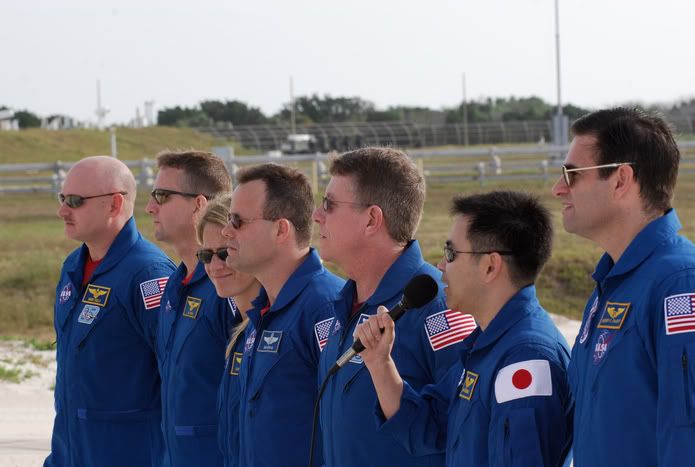
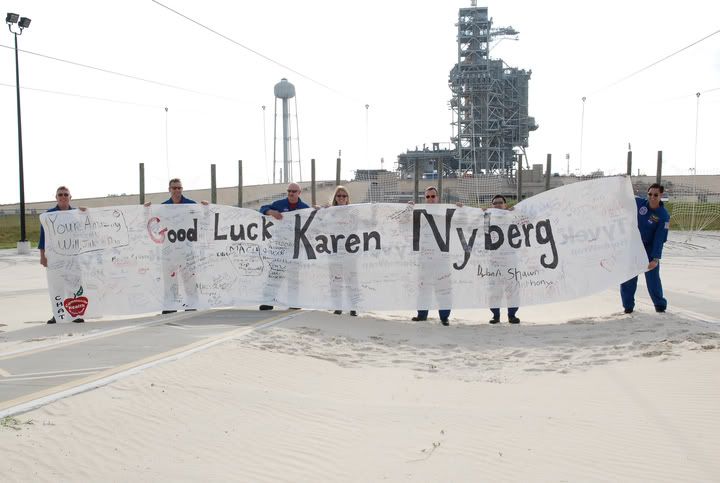
crew holds a good-luck banner presented to Mission Specialist KarenNyberg that was created and signed by students at Henning Public Schoolin the town of Henning, Minn.
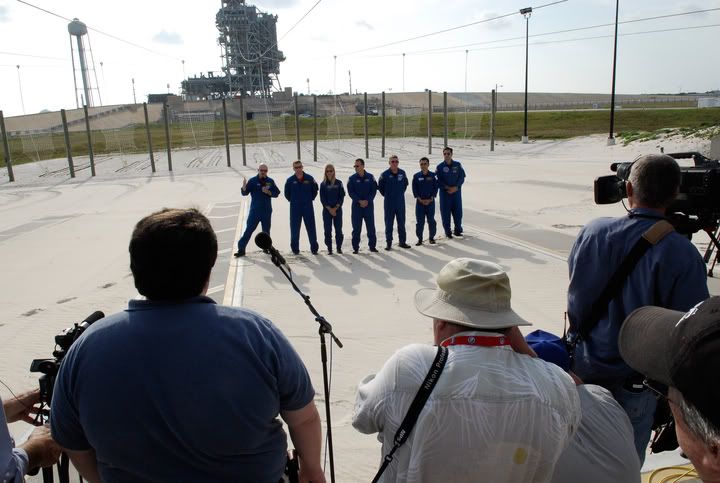
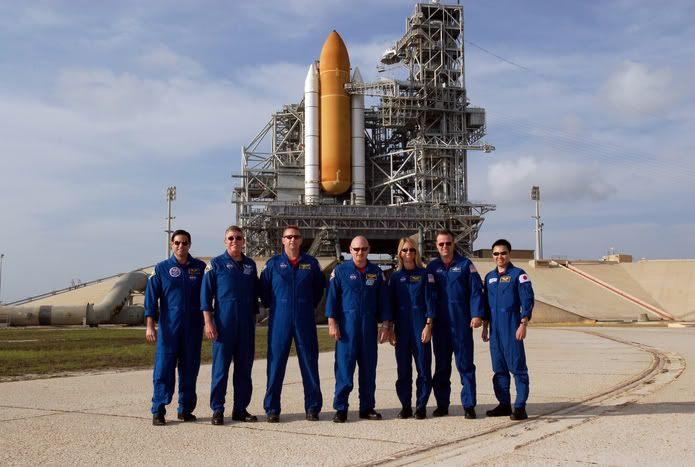
Pad 39A at NASA's Kennedy Space Center, the STS-124 crew poses for aphoto before taking part in a media question-and-answer session thatwill be conducted on the slidewire landing area.
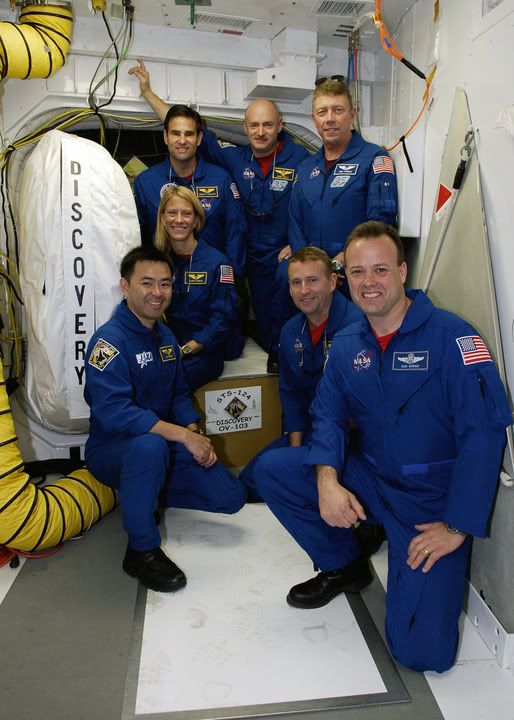
Pad 39A at NASA's Kennedy Space Center, the STS-124 crew poses outside the hatch of space shuttle Discovery.
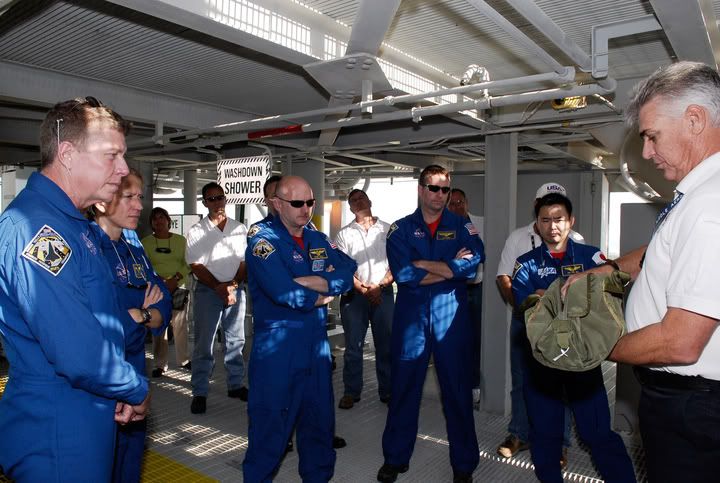
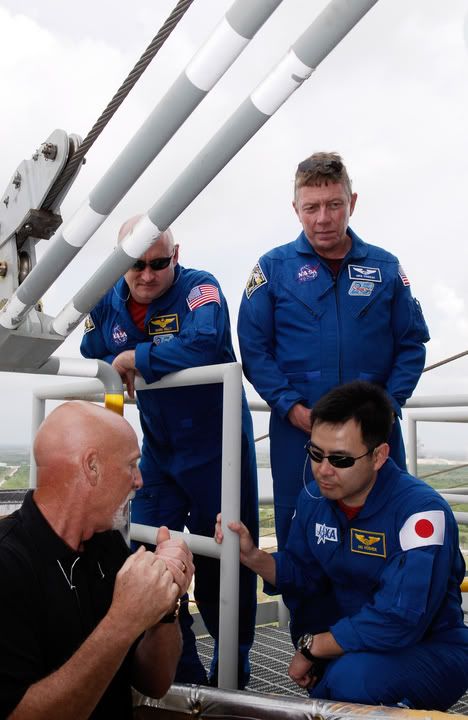
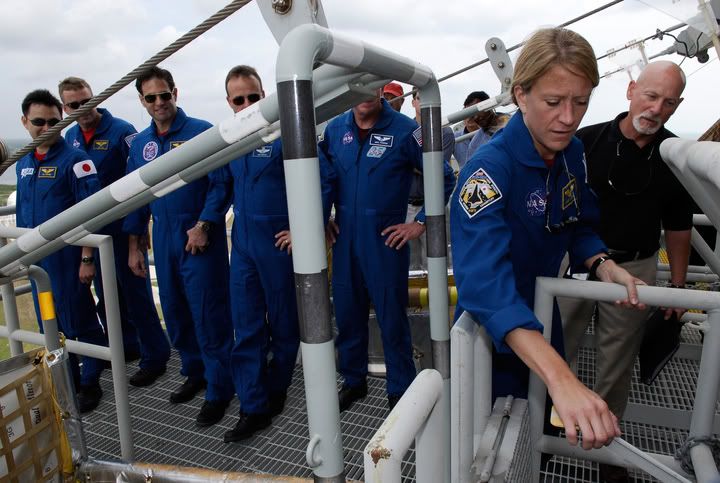
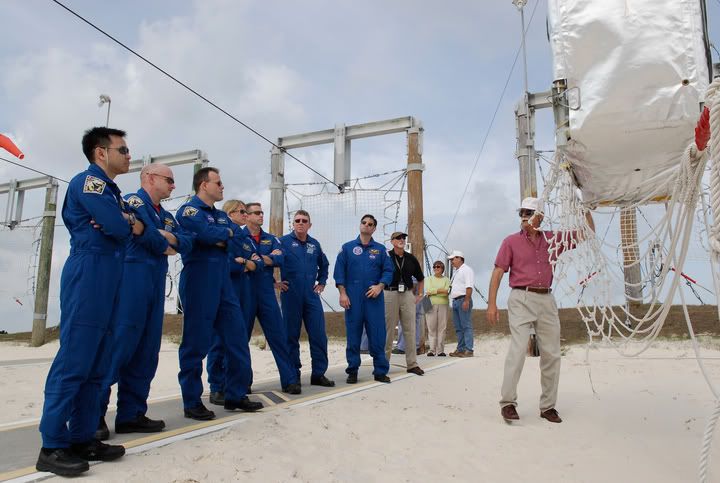
Pad 39A at NASA's Kennedy Space Center, the STS-124 crew gets safetyinstructions for exiting the fixed service structure in the event of anemergency.
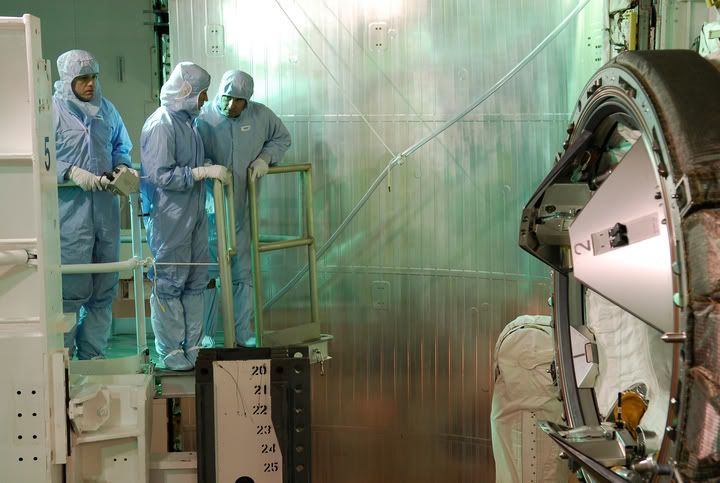
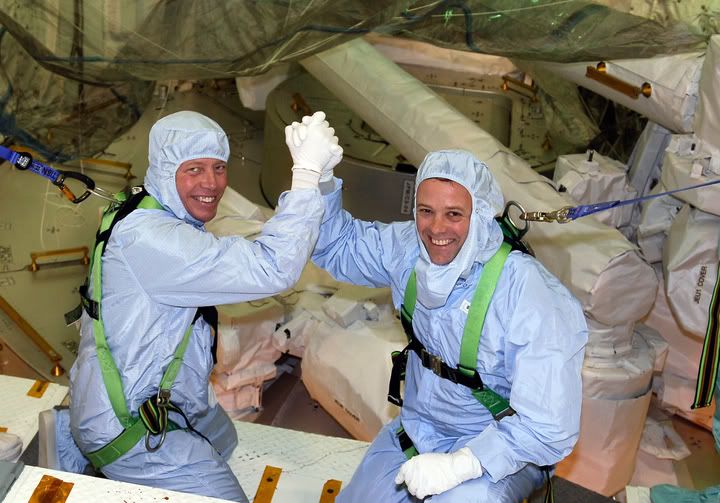
Pad 39A at NASA's Kennedy Space Center, STS-124 crew members get aclose look at the orbital docking system in space shuttle Discovery'spayload bay.
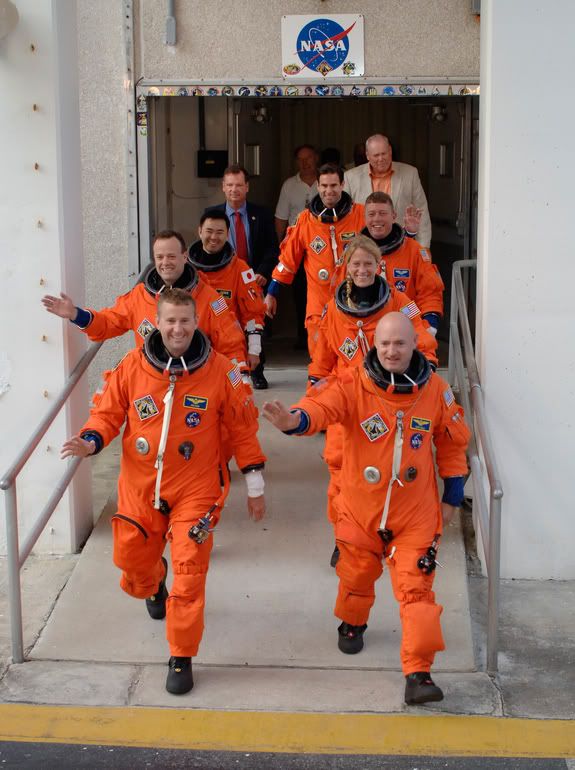
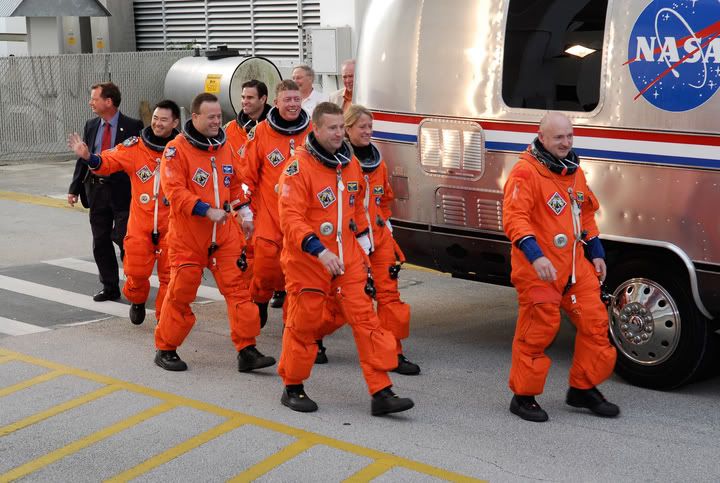
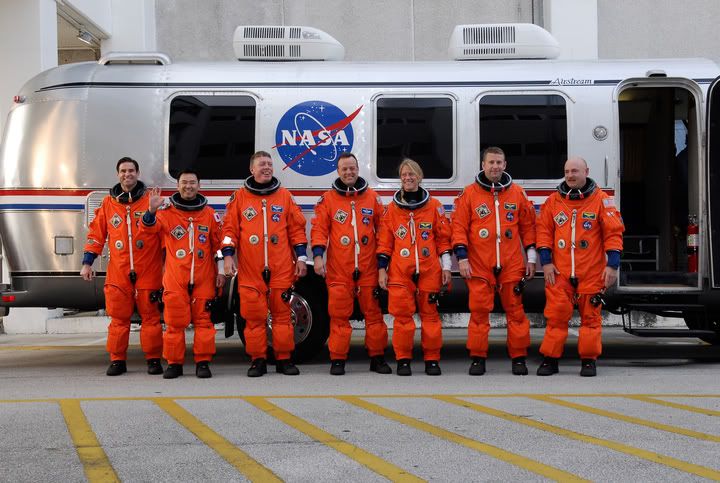
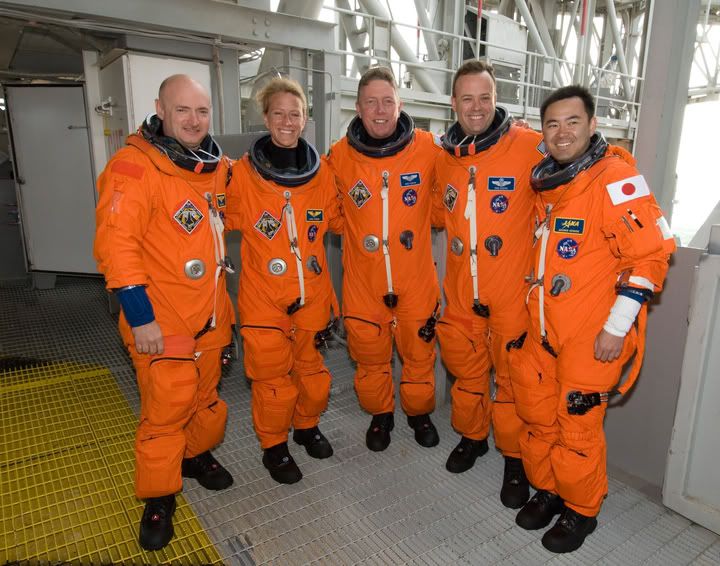
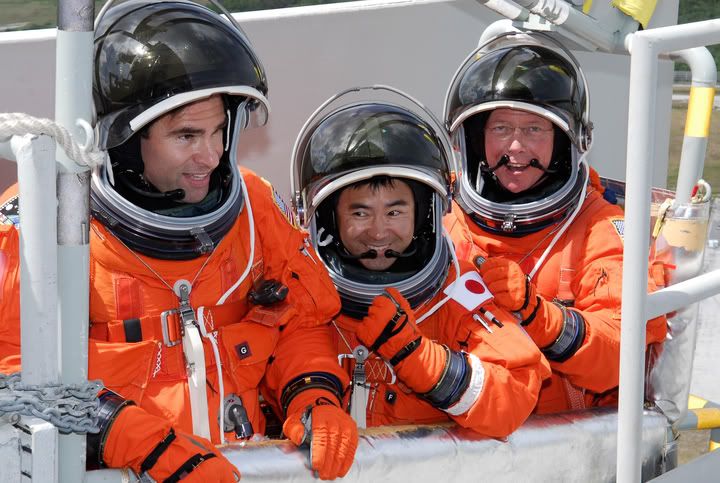
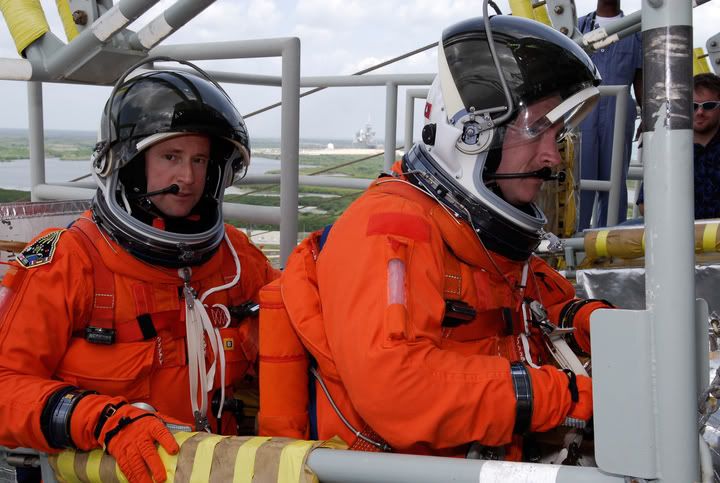
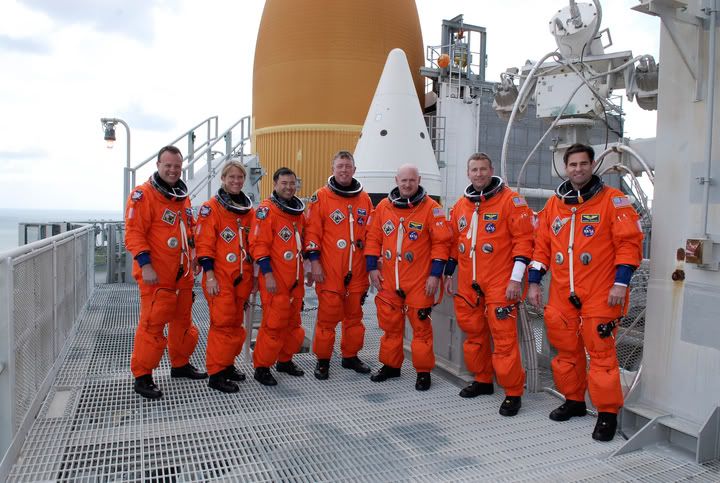
Pad 39A at NASA's Kennedy Space Center, the STS-124 crew stands for a phot on the 205-foot level of the fixed service structure.
The crew is completing the launch dress rehearsal known as the terminal countdown demonstration test.
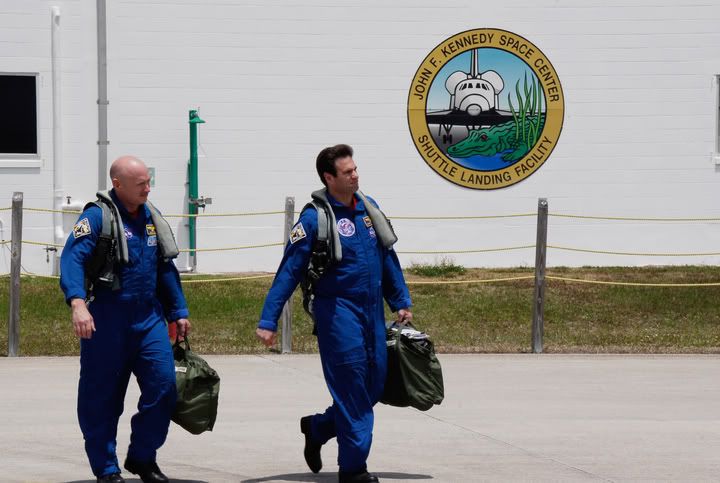
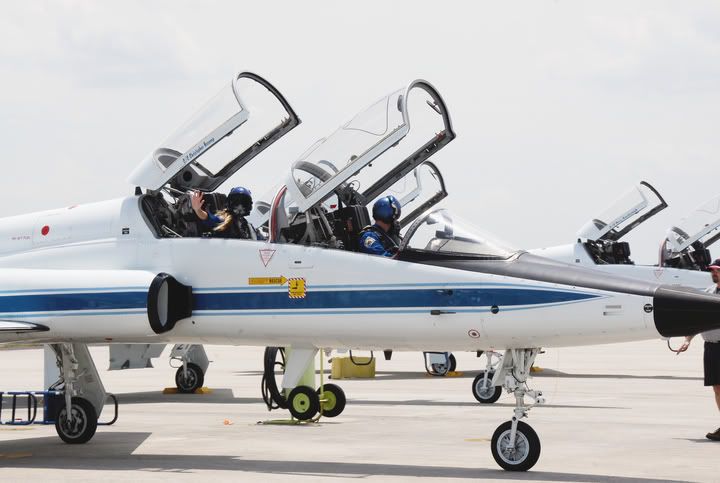
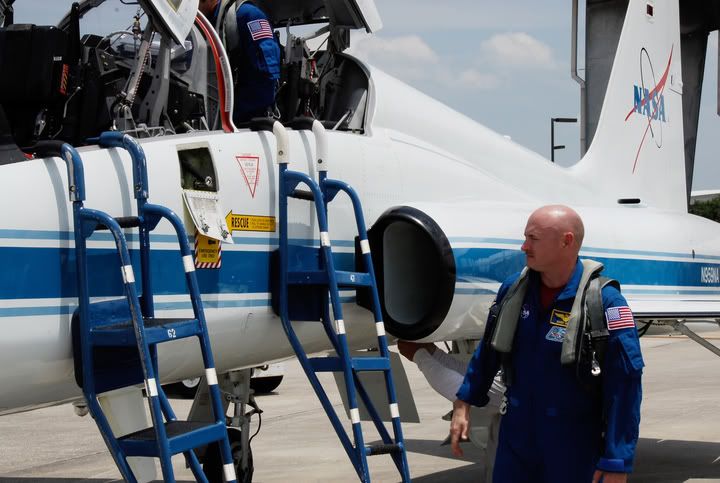
crewmembers for the STS-124 mission, depart NASA's Kennedy Space Center in aT-38 training jet after a successful launch dress rehearsal called theterminal countdown demonstration test. The crew is expected to returnin late May for the May 31 launch of space shuttle Discovery. On theSTS-124 mission, the crew will deliver and install the JapaneseExperiment Module – Pressurized Module and Japanese Remote ManipulatorSystem.
[ 本帖最后由 kl90 于 10-5-2008 12:19 PM 编辑 ] |
|
|
|
|
|
|
|
|
|
|
|

楼主 |
发表于 12-5-2008 09:04 AM
|
显示全部楼层
日本将立法允许太空军事化
http://news.bbc.co.uk/chinese/si ... 7391900/7391981.stm
日本国会的一个委员会支持一项太空军事化的立法,将扭转长达40年的限制日本在太空从事军事活动的政策。该法案得到执政联盟和主要的反对党支持,可能在今后几个星期内通过成为法律。
法案将允许使用用于国防目的的太空技术。日本议员说,日本仍然反对将武器送入太空,但是日本60年代通过的法案窒息了日本公司的创新精神。
因为日本仍然是个和平国家,所以上述决定具有争议性。新立法将扭转1969年国会通过的决议,该决议将日本的太空活动限制在非军事领域。
新立法意味着日本国防部能够开发和使用间谍卫星和其他用于加强日本国防的装置。
中国去年进行用导弹击毁了自己的一枚气象卫星,引起日本的警惕。但是在日本国会就新法案举行辩论期间,日本议员表示,仍然反对将武器带入太空。
10年前当朝鲜试射的导弹飞越日本领土时,日本就开始加强国防研究。日本同美国一起开发了导弹防御系统,试图保护自己的城市和军事设施。
日本还有自己的太空计划。目前日本的一个卫星正在对月球进行测绘。
日本国会投票是在中国国家主席胡锦涛访问日本期间进行 的 。到目前为止中国还没有对此做出反应。 |
|
|
|
|
|
|
|
|
|
|
|
 发表于 14-5-2008 09:12 AM
|
显示全部楼层
发表于 14-5-2008 09:12 AM
|
显示全部楼层
http://www.floridatoday.com/apps/pbcs.dll/section?category=news02
Two days of schedule padding lost
Two days of schedule padding likely will be lost replacing a failed multiplexer-demultiplexer in Discovery's aft section.
The May 31 launch date will not change, NASA spokesman Allard Beutel said.
"That's why you get ahead when you can," said Beutel, noting that efficient technicians have added seven contingency days to Discovery's schedule in the past month.
Fueling the shuttle's steering jets, scheduled for completion today, must stop while crews replace the electronic relay. Each shuttle has 23 such relays. The replacement will be made by Monday when the Executive Flight Readiness Review will meet to officially set May 31 as the launch date, said Beutel. Launch time is 5:02 p.m. EDT.
Today a program level Flight Readiness Review met and discussed several minor technical issues. Discovery has a historic low number of technical problems.
--------------------------------------------------------------------------------------------------------------
Phoenix lander closes in on Mars
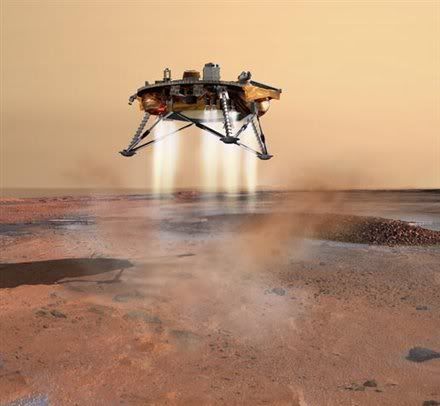
NASA's Phoenix lander is closing in on Mars and all systems are go for an unprecedented attempt to touch down near the planet's north pole and dig up water ice buried beneath the surface.
"The spacecraft is in perfect health right now," said Barry Goldstein, NASA's Phoenix program manager at the Jet Propulsion Laboratory in Pasadena, Calif. "The journey has been so remarkably uneventul, it's scary how clean it's been."
Mission managers have encountered only one minor problem -- a galactic cosmic ray caused a flight computer glitch back in October -- during the spacecraft's 10-month voyage from Earth.
Launched Aug. 4 aboard a United Launch Alliance Delta 2 rocket at Cape Canaveral Air Force Station, the Phoenix lander is nearing the end of a 422-million-mile journey through the inner solar system. The spacecraft is scheduled to land May 25 on a flat, rock-free arctic plain where evidence of water ice was detected by NASA's Mars Odyssey orbiter. Touchdown is scheduled around 7:38 p.m. EDT. Radio transit time between Earth and Mars will be about 15 minutes, so confirmation of landing isn't expected until about 7:53 p.m. EDT.
Equipped with a robotic arm that sports a scoop and drill-like rasp, the Phoenic is designed to dig up water ice and then place samples within miniature laboratories on the lander's deck. The samples will be analyzed to determine if they contain organic materials -- evidence that the area might be a habitable zone for microbial life.
Ed Weiler, NASA's Associate Administrator for the agency's Science Mission Directorate, reminded reporters in a news briefing that landing on Mars is difficult -- 55 percent of the landers sent to the red planet from Earth have failed.
"This is no trip to grandma's for the weekend," he said. "Mars has been known to cause trouble, and I'll be worried until I hear the signals a few seconds after landing."
-------------------------------------------------------------------------------------------------------------
McCulley can't predict job losses
The political climate likely will determine how many United Space Alliance workers keep their jobs after the end of the shuttle program in 2010, when some 6,400 space workers are expected to lose their jobs at Kennedy Space Center.
Retired USA CEO Michael J. McCulley, a former astronaut, said today that he cannot yet predict how many jobs USA will retain during the five-year gap between the end of the shuttle program and the beginning of the next manned spaceflight program, Constellation.
"It's too dependent on the next President, the election. There are too many things out there," said McCulley, who recently retired from USA and spoke to the National Space Club at a Cocoa Beach hotel.
USA is the prime contractor for the shuttle and employs 6,200 at KSC, nearly half the center workforce. NASA expects to reduce the KSC workforce by 6,400. USA, however, might be able to land a good portion of the shuttle decommissioning work.
"There's a big hunk of work post-last flight, and I think there are a lot of jobs in there," he added.
USA recently changed its logo, removing the shuttle image and incorporating parts of the Constellation logo. Some 1,300 USA workers already work on the Constellation project.
"The new logo reflects that USA intends to be part of this in the future," said McCulley. "There's a huge bump in the road coming."
A naval aviator with 400 carrier landings and a shuttle mission, McCulley retired from NASA in 1990 and joined private industry. He became USA's CEO in 2003.
McCulley said that the coming five years of dependence on the Russian Soyuz capsules won't be as bad as many in the space industry fear. Despite two recent emergency Soyuz landings, the Russians have been dependable transportation to the International Space Station, he said.
"You've got to think of the Russians in a positive way," he said. "They have been and will continue to be a wonderful partner."
However, he added that the U.S. is giving up leadership in human spaceflight, a move he hates to see.
"It's bad enough to not be the leader," he said, quoting a friend. "It's worse if you've been the leader and give it up."
[ 本帖最后由 kl90 于 15-5-2008 10:32 AM 编辑 ] |
|
|
|
|
|
|
|
|
|
|
|
 发表于 15-5-2008 10:32 AM
|
显示全部楼层
发表于 15-5-2008 10:32 AM
|
显示全部楼层
http://www.floridatoday.com/apps/pbcs.dll/section?category=news02
Space freighter blast off for station
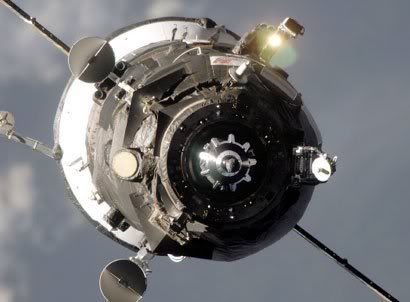
A robotic Russian Progress space freighter is on its way to the International Space Station today after launch from Baikonur Cosmodrome in Kazakhstan.
The Progress cargo carrier blasted off around 4:22 p.m. EDT and then reached orbit about nine minutes later. The bug-shaped spacecraft is scheduled to dock at the international outpost around 5:37 p.m. EDT Friday. Awaiting its arrival will be outpost commander Sergei Volkov and flight engineers Oleg Kononenko and Garrett Reisman.
The Progress-29 vehicle is carrying more than 2.3 tons of fuel, air, water and other supplies and equipment. Of that, there are 770 pounds of propellant, more than 100 pounds of oxygen and air, about 116 gallons of water and 2,850 pounds of dry cargo. Total weight of all supplies is 4,657 pounds.
You can watch live coverage of the Progress arrival at the station right here in The Flame Trench. NASA TV coverage of the docking will be webcast here beginning at 5 p.m. EDT Friday. Simply click "Watch NASA TV" link at the top of the page to launch our NASA TV viewer.
The space freighter is designed to use an automatic system to dock with the station. Volkov will be standing by to take manual control of the craft if that becomes necessary.
[ 本帖最后由 kl90 于 15-5-2008 10:35 AM 编辑 ] |
|
|
|
|
|
|
|
|
|
|
|
 发表于 17-5-2008 03:57 PM
|
显示全部楼层
发表于 17-5-2008 03:57 PM
|
显示全部楼层
Russian supply ship moored at station
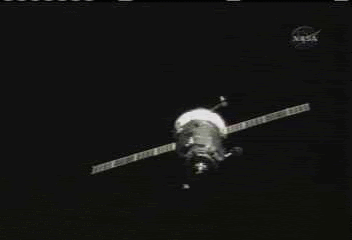
A robotic Russian supply ship is moored at the International Space Station today after a textbook rendezvous and docking some 200 miles above the planet.
The bug-shaped spacecraft auto-piloted itself on a looping flyaround of the outpost before making a slow, methodical final approach to the Earth-facing port of the Zarya module, which was launched in November 1998 and served as the cornerstone building block -- the first element -- of the station.
Filled more than two tons of supplies and equipment, the Progress-29 cargo carrier docked at the station at 4:39 p.m. EDT as both spacecraft were circling high above the east coast of Brazil, headed toward the equator. The vehicle was traveling at a glacial speed of one-teeth-of-a-meter per second when it linked up with the station.
"Okay, guys. Congratulations with the successful docking," an unidentified flight controller said from the Russian Mission Control Center in Korolev outside Moscow.
"Thank you," station commander Sergei Volkov, who stood ready to take manual control of the Progress in the event of an emergency. Station flight engineers Oleg Kononenko and Garrett Reisman also are onboard the outpost.
The docking capped a two-day trip that started with a launch Wednesday from Baikonur Cosmodrome in Kazakhstan.
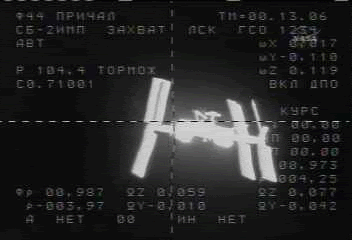
The Progress-29 vehicle is carrying more than 2.3 tons of fuel, air, water and other supplies and equipment. Of that, there are 770 pounds of propellant, more than 100 pounds of oxygen and air, about 116 gallons of water and 2,850 pounds of dry cargo. Total weight of all supplies is 4,657 pounds.
------------------------------------------------------------------------------------------------------------
Hubble slip will bump back Ares test flight
A five-week slip in NASA's final Hubble Space Telescope servicing mission likely will have a ripple effect, pushing back the planned launch next April of the agency's first Ares rocket test flight at Kennedy Space Center to late May 2009, officials said today.
"Right now, the first blush impact assessment suggests a day-for-day slip," said Jeff Hanley, manager of NASA's Project Constellation Program Office, which is developing the Ares 1 and Ares 5 rockets along with Apollo-style Orion capsules and Altair lunar landers for a planned American return to the moon by 2020.
But project engineers and managers are looking at ways to mitigate the shuttle mission delay and reduce the resulting slip to the Ares 1 test flight. "We're working on that. We'll see," Hanley said.
The Ares 1-X mission will be the first of four test flights slated to be carried out under a $1.8 billion contract to design, develop and test the rocket's first stage: a five-segment shuttle-derived solid rocket booster.
The test flight originally was set for launch next April 15 from KSC's launch pad 39B -- the same pad NASA aims to use to launch a rapid-response rescue flight if Atlantis is critically damaged during the agency's fifth and final Hubble Space Telescope servicing mission.
Astronauts on that flight won't be able to seek safe haven on the International Space Station because the Hubble telescope is in an entirely different orbit, and Atlantis won't have enough propellant to fly to the outpost in an emergency. So NASA intends to have Endeavour ready to fly on pad 39B when Atlantis launches from pad 39A.
NASA had planned to launch the Hubble servicing mission on Aug. 28, but a slow-down in shuttle external tank production is forcing the agency to push back the flight.
Senior managers next Thursday will consider changing the target launch date for the launch to Oct. 8, a move that's largely the result of the extra time now required to manufacture shuttle external tanks equipped with all post-Columbia safety modifications.
The slip also will delay the turn-over of pad 39B to the Ares 1X test team. That will delay pad modifications and launch preparations, forcing a launch delay until sometime in late May 2009, Hanley said.
The inaugural test flight will employ a four-segment shuttle booster, an empty fifth segment and mock-ups of an Ares 1 second atage, Orion spacecraft and a tractor-rocket launch abort system. The empty fifth segment and the dummy upper stages will act as mass simulators that sport outer mold lines that are aerodynamically exact copies of Ares 1 rocket hardware and Orion spacecraft.
The $320 million mission will test first-stage flight control systems as well as the system that separates the first and second stage along with the parachutes that lower the first to the ocean's surface.
The test flight is aimed at ferreting out any design changes that should be made prior to a planned critical design review of all Ares 1 rocket systems in March of 2010. Ares 1 project manager Steve Cook of NASA's Marshall Space Flight Center said data from the test flight is needed at least six months ahead of the review.
-------------------------------------------------------------------------------------------------------------
NASA eyes new Oct. 8 date for Hubble mission
NASA is expected to set new target launch dates next week for what likely will be the final two shuttle flights of 2008 -- a highly anticipated Hubble Space Telescope servicing mission and a supply run to the International Space Station, officials said Thursday.
Senior managers next Thursday will consider changing the target launch date for NASA's fifth and final Hubble servicing call to Oct. 8 from Aug.28, a move that's largely the result of the extra time now required to manufacture shuttle external tanks equipped with all post-Columbia safety modifications.
The managers also will consider changing the target launch date for Endeavour and the following flight -- a mission to outfit the station for crews of six -- to Nov. 10 from Oct. 16.
A mission to deliver the fourth and final set of massive American solar arrays is expected to remain officially targeted for launch on Dec. 4 but the mission "more than likely" will end up slipping into the early part of next year, said Kyle Herring, a spokesman for NASA's Johnson Space Center in Houston. A mid-February date is more realistic.
NASA had hoped to launch six shuttle missions in 2008. The European Space Agency's Columbus science laboratory and the first of three sections of the Japanese Kibo science research facility were launched in February and March, respectively. Discovery and seven astronauts are tentatively scheduled for a May 31 launch on a mission to deliver the Japanese Kibo laboratory module to the station.
Senior NASA managers will meet in a traditional flight readiness review at Kennedy Space Center next Monday. The May 31 date is expected to be firmed up, but a review of the Russian investigation into the an off-course April 19 return of the station's Expedition 16 crew will be conducted.
"Absolutely it's going to be part of the discussion," Herring said. "I think there's a desire to know what the latest is on the investigation."
A Russian Soyuz spacecraft carrying NASA astronaut Peggy Whitson slipped out of its intended flight path and onto a steep trajectory that subjected she and her crew to 8 Gs -- or forces eight times normal gravity -- more than double the forces NASA shuttle crews face. Russian cosmonaut Yuri Malenchenko and South Korean astronaut Yi So-yeon also were onboard.
None of the astronauts were injured. But it was the second consecutive "ballistic" reentry for Soyuz spacecraft and the third since 2003. So the Russian Federal Space Agency and its contractors are trying to determine the cause. The Soyuz crew transports serve as lifeboats at the station.
NASA astronaut Garrett Reisman now is serving as a flight engineer aboard the station. He is scheduled to return to Earth aboard Discovery. Reisman's replacement, Gregory Chamitoff -- will fly up on Discovery and return to Earth on the Endeavour supply run in November. |
|
|
|
|
|
|
|
|
|
|
|
 发表于 20-5-2008 09:21 AM
|
显示全部楼层
发表于 20-5-2008 09:21 AM
|
显示全部楼层
http://www.floridatoday.com/apps/pbcs.dll/section?category=news02
NASA managers "go" for May 31 launch; space agency discusses Soyuz lifeboat safety
Top NASA managers have confirmed 5:02 p.m. EDT May 31 for the launch of Discovery to deliver a massive Japanese laboratory module to the International Space Station.
Watch NASA-TV live in The Flame Trench for a report from a press briefing scheduled to begin at 4 p.m.
While Discovery passed the Executive Flight Readiness Review easily, engineers had concerns about the Soyuz craft now at the station. The Russian spacecraft has had problems during the past two landings. It will be the escape vessel for U.S. astronaut Greg Chamitoff and two cosmonauts should something go wrong with the station during the next six months.
NASA space operations chief Bill Gerstenmaier said that the Soyuz capability as a return vehicle in an emergency was deemed acceptable but he said that there is a lot of work to be done by the Russians before the routine return to Earth at the end of the current station crew's mission in October. He has not yet elaborated on that.
Gerstenmaier has not addressed what that might mean for the U.S. crew members that are now or will be living aboard the space station the rest of this year. He did say, however, there was nothing about the Soyuz situation that would delay the launch of this shuttle mission on May 31.
Gerstenmaier said that -- as of right now -- the plan is to go ahead and leave Chamitoff behind on station because the Soyuz is a safe return vehicle based on the information available today. If something comes up that questions the safety of the Soyuz between now and May 31, the U.S. could evaluate that information and change the plan, he said. But "there is nothing to indicate" that kind of problem right now. A preliminary Russian investigative report mayb be out before the shuttle's scheduled launch, he said.
Gerstenmaier did make one important distinction that sheds light on NASA's position. He said clearly that Soyuz is acceptable as an emergency return vehicle, but NASA has not yet deemed the Soyuz acceptable for a normal return. How is that? Gerstenmaier said the reason is the low probability of an emergency evacuation aboard Soyuz allows the space agency to accept a higher degree of risk. He said the odds of emergency evacuation on a Soyuz during a six-month station increment was about 1 in 124, according to a newly-refined analysis.
During a 14-day mission with three spacewalks, Discovery's crew of seven will deliver the 32,600-pound Kibo module to the space station and latch it in place. Kibo is the second of three Japanese pieces of the space station.
-----------------------------------------------------------------------------------------------------------
Soyuz discussion could slow FRR outcome
A discussion of last month's emergency Soyuz landing could delay the 4 p.m. press briefing after today's Executive Flight Readiness Review.
Today at Kennedy Space Center, top NASA managers are meeting to decide whether to confirm May 31 as the launch day for Discovery's flight to the International Space Station.
The external tank and the solid rocket boosters have been discussed. While no major technical issues exist with Discovery, NASA managers are likely to discuss in detail the Russian investigation into the ballistic re-entry of the Soyuz capsule that carried beloved U.S. astronaut Peggy Whitson, cosmonaut Yuri Malenchenko and a South Korean spaceflight participant.
It was the second such emergency landing in a row. The capsule landed 300 miles off course, after the emergency sequence was triggered by a malfunction in the spacecraft.
Space station crews, which include Americans, would rely on the Soyuz craft for an emergency escape from the station. Additionally, the U.S. will depend on the Soyuz to bring crew members to the space station after the shuttle stops flying in 2010.
"The Soyuz discussion is going to take a (large block) of time," NASA spokesman Allard Beutel said.
Watch The Flame Trench this afternoon for reports from the FRR. A press conference after the meeting will be televised on NASA-TV, which you can watch here on your computer.
Though two days of schedule padding were lost for the replacement of an electronic relay, STS-124 processing remains on track for a May 31 launch at 5:02 p.m. EDT to deliver the 37-foot Kibo module to the station. Three spacewalks will be performed during the 14-day mission.
A historic low number of technical issues have arisen during Discovery's processing.
----------------------------------------------------------------------------------------------------------
See what Congress has in store for NASA
A House Science and Technology panel will vote Tuesday on legislation to reauthorize NASA for another year.
You can download the full legislation here.
Congress last approved such a measure in 2005, reauthorizing the space agency for three years. This time around, the reauthorization bill would expire in a year. The bi-partisan sponsors of the legislation hope that would allow the incoming president to put his or her stamp on NASA's mission.
The "NASA Authorization Act of 2008" authorizes about $20.2 billion for the space agency next year, about $2.6 billion more than what the White House recommended in its 2009 budget.
But whether that extra money makes it through the appropriations process is another matter _ and highly unlikely based on similar attempts in the past several years by NASA supporters in Congress. |
|
|
|
|
|
|
|
|
|
|
|
 发表于 23-5-2008 01:43 PM
|
显示全部楼层
发表于 23-5-2008 01:43 PM
|
显示全部楼层
Discovery on track; other launch dates announced
The launch pad 39A surface and the flame trench will be washed down today to reduce debris during the May 31 launch.
Discovery will blast off at 5:02 p.m. EDT on a trip to the International Space Station.
However, NASA today announced adjusted target launch dates for two other space shuttle missions in 2008. Shuttle Atlantis' STS-125 mission to the Hubble Space Telescope is now targeted for Oct. 8, and Endeavour's STS-126 supply mission to the International Space Station has moved from Oct. 16 to Nov. 10.
The Hubble mission was moved from Aug. 28 due to a delay of the external fuel tanks, and the need to have two tanks on hand to prepare Endeavour for a possible rescue mission approximately two weeks after STS-125 launches.
At Pad 39A, other tasks today include white room and cabin pressurization preps and an orbiter aft configuration test. Also, the multifunction display units in the cockpit will be cleaned.
STS-124 will deliver the 37-foot Kibo module to the International Space Station. Three spacewalks will be performed during the 14-day mission.
STS-124 is the 10th shuttle flight since the Columbia accident, and 10 flights are scheduled until the shuttle stops flying in 2010.
-------------------------------------------------------------------------------------------------------------
Obama says he supports NASA and Orion, but also questions human vs. robotic exploration
After months of varying policy statements on the issue of space exploration, Democratic presidential candidate Barack Obama gave what sounded like a more firm commitment to NASA's plans to build the Orion spacecraft to replace the space shuttle.
In a town-hall style meeting and rally in Kissimmee last night, the Democrats' likely nominee fielded questions from a crowd that included some folks from Brevard County with an interest in the space program.
Here's a little of what he said:
"I want us to understand what it is we want to accomplish, so we can continue to build this program. Other countries are in position to leapfrog us if we don't continue to make this investment."
Our story in this morning's newspaper, written by reporter Susanne Cervenka, goes on to report the question-and-answer exchange between Obama and a Space Coast resident. Here's what the story said:
Obama said he would fund a strengthened space program, including the Orion program, which is designed to return Americans to the moon and later get them to Mars.
Obama said he wanted to revive the energy the country had for the space program during the Mercury and Apollo programs. The Mercury program launched the first Americans into space, and the Apollo program landed Americans on the moon.
"Now, even though lots of good work is being done with the shuttle program, I don't think people have as deep of a commitment to the space program," he said.
The remarks eased concerns of aerospace engineer Angel Andujar, who asked Obama about his plans for the space program.
"At least he's looking into it," said Andujar, 24, of Palm Bay. "He wants to make sure we're not just wasting money, that NASA and the government have a vision, one goal in mind."
You can read the full story here and talk about it in Space Chat here.
However, you can also hear him question the value of human vs. robotic exploration with NASA in this video of the event. He said robotic exploration provided bigger bang for America's buck. The NASA-related part of the video covers about the final one minute, with a question from the Kennedy Space Center worker. Obama said is committed to the world's best space program, but he also questioned if the U.S. would be "better off" using unmanned craft instead of human explorers.
Those of you who've followed what Obama said so far might remember his campaign's policy statement calling for a five-year delay in the Constellation Project to fund education programs as well as Obama's questioning of the goal of sending astronauts to the moon and Mars during meetings with reporters and newspaper editorial boards in other primary states.
The questions and answers in Kissimmee did not clear up all of those issues, but did sound as though Obama's position on NASA is firming up enough to give Space Coast residents something to chew on (and likely some follow-up questions).
------------------------------------------------------------------------------------------------------------
Explosives connected for Discovery launch
A series of explosive bolts and self-destruction devices was connected last night, as Discovery is prepared for a May 31 launch.
At the Executive Flight Readiness Review on Monday, top NASA managers approved a 5:02 p.m. launch on a schedule that gives workers four days off for Memorial Day, a first since the Return to Flight after the Columbia accident in 2003.
Explosive ordnance includes solid rocket booster ignition, launch release and separation bolts, jettison devices and safety destruct devices.
Today at pad 39A, aft closeouts are in work and the external tank is being purged. Engineers will continue testing of a replaced multiplexer-demultiplexer in the shuttle's aft.
STS-124 will deliver the 37-foot Kibo module to the International Space Station. Three spacewalks will be performed during the 14-day mission.
STS-124 is the 10th shuttle flight since the Columbia accident, and 10 flights are scheduled until the shuttle stops flying in 2010.
-------------------------------------------------------------------------------------------------------------
U.S. House panel votes for 1 extra shuttle flight
A House panel has approved legislation that lays out a congressional blueprint for NASA for the next year.
The “NASA Authorization Act of 2008” bill gives NASA the green light to pursue some significant goals. Among them, it would add three shuttle flights to the International Space Station before the entire fleet is retired. Two of those flights are now labeled as “contingency;” the third is a brand new flight that would take the Alpha Magnetic Spectrometer to the International Space Station.
The bill would also authorize about $20.2 billion for NASA, about $2.6 billion more than what the White House recommended in its 2009 budget. About $1 billion of the extra money is specifically to accelerate the Constellation program.
The bill also encourages international cooperation, particularly in building the replacement for the shuttle.
Congress last approved a reauthorization bill for NASA, a three-year measure, in 2005. This time around, the reauthorization bill would expire in a year. The bi-partisan sponsors of the legislation hope that would allow the incoming president to put his or her stamp on NASA's mission.
“It would be foolish to try to pass a bill that would go deep into the next administration when candidly none of the candidates have said a whole lot of detailed stuff about space,” said Rep. Tom Feeney, the top Republican on the House Space and Aeronautics Subcommittee, which voted on the bill.
Feeney acknowledged it’s uncertain whether any NASA money will make it through the appropriations process this year. Congressional leaders have hesitated passing any funding bills so far, outside of spending measures for U.S. troops in Iraq and Afghanistan, hoping that the next president will immediately outline his or her spending priorities once in office.
“The next administration could go six or eight months before they even have a NASA administrator in place,” Feeney said. “It could take them another several months before they have a plan. So it’s very important that we start that administration, whether it’s Republican or Democrat, in a position where we have in general a bipartisan agreement for what America’s space program ought to be going.”
The legislation was hardly controversial. In addition to Feeney, only one other lawmaker attended the hearing _ Louisiana Rep. Charlie Melancon, one of the panel’s lower ranking Democrats who was brought in to preside over the hearing.
The full House Science and Technology Committee is scheduled to take up the bill early next month. |
|
|
|
|
|
|
|
|
|
|
|

楼主 |
发表于 26-5-2008 07:04 PM
|
显示全部楼层
鳳凰號成功降落火星北極地區 展開90天任務
http://tw.news.yahoo.com/article/url/d/a/080526/19/zyfd.html
(法新社巴沙迪納二十五日電) 美國航空暨太空總署的火星探測器「鳳凰號」,今天在火星北極附近成功降落,成為降落在火星北極表面的首個探測器,將展開為期九十天的鑽探任務。
「鳳凰號」傳回已安然通過熾熱火星大氣層的訊號後,美國航空暨太空總署「噴射推進實驗室」的任務控制中心雀躍慶祝。
「鳳凰號」將成為第一艘研究火星北極表面的太空船。與美國航空暨太空總署的兩架火星探測漫遊車不同的是,「鳳凰號」將停駐在定點,它將利用機械手臂,鑽挖火星極區冰層,以研究火星上是否有適合生命生存的環境。
----------------------------------------------------------------------------------------
太空探索NASA鳳凰號成功登陸火星北極 將尋找生命(
http://tw.news.yahoo.com/article/url/d/a/080526/17/zyim.html
美國太空總署(NASA)火星探測器「鳳凰號」已經在台北時間今天(26日)上午7點38分,完成「關鍵7分鐘」的降落程序,成功降落火星的北極區,將探測火星生命跡象。
所謂關鍵7分鐘是指鳳凰號以時速每小時2萬1000公里進入火星大氣層,進入大氣層後必須完成一系列標準動作,再把飛行時速降到約每小時8公里,然後緊急剎車,以便進行軟著陸。
NASA事前評估這次降落成功率只有五成,因此當鳳凰號成功著陸,位於加州帕沙迪納的NASA噴射推進實驗室任務控制中心人員都興奮不已,NASA歷年來機率五成的火星降落任務都以失敗,火星向來以吞噬太空船出名,過去各國嘗試降落火星的任務有一半都宣告失敗;四年前NASA的機會號和精神號是採用降落傘和緩衝氣墊併用的方式著陸。
任務經理高斯坦說:「我作夢也沒想到這會進行的如此完美。它準確降落。」
鳳凰號斥資4億2000萬美元(約新台幣128 億元)打造,這次是經過6億7900萬公里的漫長飛行後降落在火星北極周圍一帶,降落目標區是一處寬約30英里的山谷區,相當於地球上北歐地格陵蘭島,這是首次降落在火星北極區域的探測器,選擇該區是因為之前地探測照片發現當地接近地表地凍原下有冰的跡象,鳳凰號將分析極地區凍原土壤,尋找生命跡象。 |
|
|
|
|
|
|
|
|
|
|
|

楼主 |
发表于 26-5-2008 07:07 PM
|
显示全部楼层
NASA証實鳳凰號探測器成功降落在火星北極圈
http://tw.news.yahoo.com/article/url/d/a/080526/19/zyit.html
(法新社華盛頓二十五日電) 美國國家航空暨太空總署(NASA)証實,鳳凰號探測器已經在今天成功降落在嚴寒的火星北極地帶,將在這趟高危險性的任務中試圖搜尋火星生命跡象。
一名NASA官員在証實它已經成功的登陸後宣布:「鳳凰號已經著地。」
鳳凰號成功的展開降落傘,並花了七分鐘的時間讓推進器從二萬零四百公里的時速剎車,利用它的三條腿軟著陸。
從電視上可以看到位在美國加州巴沙迪納噴射推進實驗室的所有任務小組成員,在確定探測器首次成功降落火星北極後,高興的歡呼並互相擊掌、擁抱。
這具造價四億兩千萬美元的探測器,被設計來幫助科學家評估,火星北極是否曾有適合微生物生命生存的環境。
工作小組一直為這趟高危險性任務擔心,火星任務自一九六零年俄羅斯首次發動以來,成功率大約只有百分之五十。
工作人員只能在鳳凰號著陸兩個小時後,透過從火星奧德賽軌道觀測器所傳回來的照片,了解著陸和整個鳳凰號設備佈署的情況是否順利。
第一批傳回來的照片可能是鳳凰號自己的照片,顯示整個設備是否佈署妥當,然後可能傳回火星表面的照片。
鳳凰號配備有一台照相機和一個二點三五公尺長的機器手臂,可以挖掘一公尺深度尋找冰,並將它加熱以偵測碳化物、氫化物及其他的生命體。
它同時還擁有一套氣象設備,可供觀測火星的大氣層。
--------------------------------------------------------------------------------------------
為人類找新家 「鳳凰號」登陸火星
http://tw.news.yahoo.com/article/url/d/a/080526/8/zymi.html
火星上頭有沒有生命跡象,一直是美國太空總署NASA,想要解開的謎題,而答案究竟是什麼,可能很快就會揭曉。
火星人到底存不存在,NASA的鳳凰號探測器,說不定很快就能給我們答案!NASA證實,鳳凰號已經在台灣時間今天早上7點53分,降落在嚴寒的火星北極圈,研究人員開心的歡呼、擊掌、互相擁抱。
因為這具造價達到4億2千萬美元的探測器,配備有照相機和機器手臂,未來不僅可以拍攝火星的照片,還可以挖掘火星土地,幫助科學家研究火星,到底適不適合人類居住。
-------------------------------------------------------------------------------------
火星探測器鳳凰號簡介
http://tw.news.yahoo.com/article/url/d/a/080526/19/zynh.html
(法新社華盛頓二十五日電) 美國航空暨太空總署的火星探測器「鳳凰號」今天放下三支登陸腳架,成功降落在酷寒的火星北極地區,展開冰面鑽挖任務,以判定火星是否曾有適合生物存在的條件。
--造價四億兩千萬美元(約新台幣一百二十八億元)的「鳳凰號」重達三百五十公斤,其中包括二十五公斤重的科學儀器。
--「鳳凰號」降落後會展開兩片太陽能板,每片長五公尺、寬一點五公尺。
--「鳳凰號」配備伸縮挖掘裝置的機械手臂,長二點三五公尺,可向下挖掘達一公尺,及採集極地凍土和水冰的樣本,並將它們遞送至「鳳凰號」上的科學儀器,以進行詳細的化學及地質分析。
--配備箱狀照相機,安裝在機械手臂末端的挖掘鏟上,附有與用於35mm相機相仿的雙高斯鏡組,及兩具照明器材,可拍攝週遭環境和鑽挖出樣本的影像。
--探測工具之一,由加拿大打造的氣象站,將監測火星北極地區每日氣候變化,旨在探究該地區水成份變化過程。這個氣象站配備雷射雷達儀器,(光學定向與測距),利用雷射光脈衝監測此一地區大氣層的塵埃變化。
--立體照相機(SSI):美國航空暨太空總署將之稱為「鳳凰號之眼」。這個立體照相機可拍攝火星北極地區高解析度和廣角影像。安裝在離地兩公尺的高處,它的立體照相功能有助提供地球上的科學家有關機械手臂鑽測任務的三度空間立體影像。它也能垂直轉動攝影,提供火星大氣層塵埃相關資料。 |
|
|
|
|
|
|
|
|
|
|
|

楼主 |
发表于 26-5-2008 07:11 PM
|
显示全部楼层
太空探索鳳凰號踏上火星北極 傳回第一批照片
http://tw.news.yahoo.com/article/url/d/a/080526/17/zyvk.html
美國太空總署(NASA)斥資相當於新台幣128億的火星探測器「鳳凰號」已經在台北時間今天(26日)上午7點38分順利降落火星的北極地區展開探測任務。而鳳凰號也已經傳回了最新畫面。
鳳凰號降落火星北極後兩小時,傳回來第一張降落火星時拍攝的照片,從畫面中可以清楚看到,鳳凰號在降落火星時將太陽能板整個伸展開來,照片上灰白色的部份就是火星的表面。這張照片讓科學家感到相當興奮。
鳳凰號降落的地點就位在火星的北極周圍一帶,緯度相當於地球的北歐地區,這次是NASA砸下多達4億2000萬美元(約新台幣128億元)的火星探測器鳳凰號,經過長達6億7900萬公里的漫長飛行之後,順利在台北時間26日上午7點38分著陸,展開火星北極地區的探測任務。
鳳凰號在進入火星大氣層的時候速度達到每小時2萬1000公里左右,在進入大氣層之後的關鍵7分鐘,鳳凰號必須完成一系列的標準動作,最終把飛行時速降到每小時8公里左右,然後進行軟著陸。
這是首次降落在火星北極地區的探測器,科學家將利用這個機會尋找火星大氣層區域是否有過生命跡象,再次挑戰人類的極限。
------------------------------------------------------------------------------------
美國鳳凰號太空探測船 成功降落火星北極
http://tw.news.yahoo.com/article/url/d/a/080526/16/zz31.html
(路透加州巴沙迪納25日電)美國國家航空暨太空總署(NASA)官員今天表示,1艘小型的太空探測船已穿越火星的橘色天空,降落在其北極的冰凍沙漠上,開始搜尋水的蹤跡並評估維持生命的條件。
這艘鳳凰號(Phoenix)太空探測船於台北時間26日上午7時53分成功降落,這趟降落任務需穿過火星薄薄的大氣層,利用推進器在火星地表著陸,一旦失敗便將墜毀。這是太空探測船成功在火星北極地區降落的首例。
NASA的太空科學主管(Ed Weiler)表示,比起之前「精神號」(Spirit)以及「機會號」(Opportunity)探測船的降落,這次的著陸「驚險許多」;他表示:「我一直想著,要是有個安全氣囊就好了。」
鳳凰號在火星重力的牽引下,在抵達火星大氣層前時速高達2萬400公里,接著因大氣摩擦減速,之後鳳凰號打開降落傘,並開啟火箭推進器以便平緩降落。中央社(翻譯)
---------------------------------------------------------------------------------------------
降落火星北極 鳳凰號展開探索生物任務
http://tw.news.yahoo.com/article/url/d/a/080526/19/zzaf.html
(法新社華盛頓二十六日電) 在美國國家航空暨太空總署鳳凰號探測器成功降落火星北極附近,並開始傳回照片後,探查火星北極地區是否曾有微生物的具有企圖心行動今天已經展開。
加州巴沙迪納噴射推進實驗室任務控制中心計畫主管高德斯坦說,鳳凰號在太空歷經九個月的飛行後,幾乎完美的降落在一個較無岩石而平坦的地區。
官員說,美東時間二十五日晚間七時五十三分(台灣時間二十六日早上七時五十三分)所接收到的無線電訊號,證實鳳凰號成功完成艱難的最後降落,並已著陸。
航太總署署長葛里芬在聲明中說:「噴射推進實驗室小組三十二年來首度實現在火星軟著陸,這也是人類史上第三次。在此目睹這項不可思議的成就,我是再快樂不過了。」
在緊張的七分鐘降落過程,鳳凰號啟動降落傘和推進器,從時速兩萬零四百公里急速減速,並設法利用三條腿軟著陸。
依照計畫,鳳凰號在降落火星地表一分鐘後停止傳送訊號,將有限的電池電力集中在張開太陽能板和其他重要的活動。張開太陽能板對任務進行期間的能源供應至為重要。
首批傳回的照片顯示,太陽能板準確的張開,立體攝影機和氣象站的桅杆也已轉到垂直位置。
高德斯坦告訴記者:「在成功降落後看到這些照片,再度確認一個偉大團隊過去五年來工作的縝密周詳。」
但是前頭仍面臨一項關鍵性工作,即鳳凰號機械手臂的啟用。這項工作預定明天進行。
配備全副高科技設備的鳳凰號,將在北極周遭的瓦斯蒂塔斯─伯里利斯(Vastitas Borealis)平原進行為期三個月的挖掘任務,以探測火星結冰的地面下是否有液態水以及支持生命的有機礦物質的跡象。該平原的緯度相當於地球的加拿大北部。
鑒於火星極地地區有類似地球的季節變化,科學家認為火星北極可能和地球一樣,有較溫暖、適合人居住的地質紀錄。
鳳凰號在亞利桑那大學的主要研究員史密斯在這具探測器降落前表示:「我們的整個任務是挖掘,我們發現一個星球的北極地區對氣候變化真的非常敏感...它也保存了生命的歷史。」
他說:「我們認為至少在某個時期,由於流星和其他撞擊,一定存在過有機物。」
他指出,如果存在液態水和有機物,將意味那是個「適合居住的地區」。
-----------------------------------------------------------------------------------------------------
鳳凰號送回火星極地影像
http://tw.news.yahoo.com/article/url/d/a/080526/1/zzh6.html
美國的火星探測器鳳凰號早上降落火星北極後,送回當地影像。科學家說,火星極地看起來跟地球的永凍層很像。
鳳凰號經過十個月,六億七千九百萬公里的旅程,在火星北極地區降落,將在原地停留一個星期,檢查帶過去的儀器。接著將花九十天的時間,在極地挖掘,看看當地有沒有可以維持生命的物質。
美國已經派了兩艘探測船上火星了。另外兩艘特測船在火星上工作了四年。跟鳳凰號不一樣的是,這兩艘探測船是移動探測,鳳凰號是待在同一個地方進行挖掘探測。
美國航太總署表示,從落地以後的表現來看,鳳凰號的狀況很不錯。 |
|
|
|
|
|
|
|
|
|
|
|

楼主 |
发表于 27-5-2008 01:25 PM
|
显示全部楼层
火星探测器首次传回照片
http://www.zaobao.com/gj/gj080527_501.shtml
(帕萨迪纳综合电)美国宇航局发射的“凤凰号”火星探测器,于新加坡时间昨天上午降落在火星北极地区,并在不到两个小时内,第一次传回多张火星表层的照片。这将有助于人类探测火星上是否有微生物和生命迹象。
这是自1976年两艘“海盗号”火星探测器在火星降落以来,人类发射的火星探测器第一次在火星地表软着陆。
“凤凰号”是在太空飞行了10个月,飞越7亿1100万公里后,以每小时1万9000多公里的时速进入火星大气层。“凤凰号”过后花了七分钟打开降落伞,同时将时速迅速减到每小时8公里,才安全地在火星地表软着陆。
美国宇航局的工程师和科学家,在确定“凤凰号”已成功降落火星北极后,高兴地欢呼并互相击掌、拥抱。项目经理戈尔斯坦说:“即使在我的梦境中,也没有比这次登陆更完美,它完全按原先计划进行。”
“凤凰号”一共传回四打黑白照片,其中一张显示探测器的一条“腿”站立在布满碎石的火星土壤上;其他照片则展示了火星北极平原的地平线,以及同地球永久冻土地区相似、布满多边形图纹的火星地表。
美国宇航局喷射推进实验室首席科学家麦克利斯说:“简直是太美了!这看来像是一个可以开始挖掘的好地方。”
“凤凰号”将在90天的火星探测行动中,利用2.4米长的挖掘臂深挖火星地表,寻找可能埋于地下的冰,然后对所收集的尘埃和冰样本进行分析,以寻找微生物的存在。
除了挖掘臂,“凤凰号”还备有其他“武器”,可在火星北极附近区域探寻可能存在的冰层以及适宜生命存在的环境。这包括可拍摄土壤以及土壤冰层特写图像的机械臂照相机;可拍摄着陆位置地形的高清晰度、彩色、立体图像的立体照相机;可监测火星大气层的尘埃、温度等变化的气象仪;可将土壤样本加热,并测量样本中水蒸气、二氧化碳及挥发性有机物在温度上升后变化的热量和释出气体分析仪;以及显微镜以及电化学和传导性分析仪等。
科学家并不期望在“凤凰号”降落的地点找到液体状态的水,因为那里温度太低。不过,他们指出,如果火星上存在着任何生命迹象,这些迹象很可能会保存在冰里头。 |
|
|
|
|
|
|
|
|
|
|
|

楼主 |
发表于 27-5-2008 01:25 PM
|
显示全部楼层
中国首颗新一代极轨气象卫星"风云三号"发射升空
http://realtime.zaobao.com/2008/05/080527_14.shtml
(综合讯)今天上午十一时许,中国首颗新一代极轨气象卫星“风云三号”,在太原卫星发射中心由“长征四号丙”运载火箭成功发射升空。
“风云三号”是中国第二代气象卫星,将首次实现全球、全天候和三维探测,支持10至15日的中期天气预报,令天气预报周期更长和更准确,对防灾、减灾有重要作用。
“风云三号”还有广阔的应用前景,将在监测大范围自然灾害和生态环境,研究全球环境变化、气候变化规律和减灾防灾等方面发挥重要作用。同时,也可为航空、航海等部门提供全球气象资讯,并将为北京奥运会提供气象服务。
“风云三号”可以不分昼夜,对气象环境进行探测,并形成立体彩色图像,增加气象预报的精细和准确度。“风云三号”将会每日扫描地球两次,每次扫描的范围,达到2900公里。 |
|
|
|
|
|
|
|
|
|
|
|
 发表于 28-5-2008 01:20 AM
|
显示全部楼层
发表于 28-5-2008 01:20 AM
|
显示全部楼层
Up on Mars: What's The White Spot
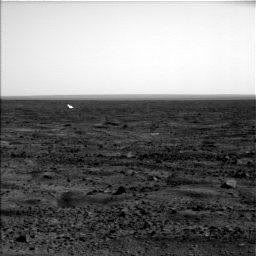
A color panorama of some of the arctic terrain surrounding NASA's Phoenix spacecraft is expected to be released soon, as early as today's 2 p.m. EDT news briefing at NASA's Jet Propulsion Laboratory in Pasadena, Calif.
The panorama will not a a full 360-degree view of the Vastitas Borealis landing site, but it will show much more than the sliver of terrain we've seen in the first two days of data beamed back through NASA's Mars Odyssey spacecraft.
We'll be webcasting the briefing live here in The Flame Trench. Simply click the link below the NASA TV box at the top of the page to launch our NASA TV viewer. The briefing will be the first dual-site news conference of the Phoenix surface operations campaign. We'll hear from folks at the Lunar and Planetary Laboratory at the University of Arizona in Tucson, which is leading the mission under NASA project management.
In the meantime, people are puzzling over the image at the top of this post. It shows some sort of big, white, something-or-another on the surface between the Phoenix lander and the horizon, at about 10 o'clock. Some think it might be a big. lonely boulder on an otherwise pebbly plain. Others thin it might be the hard aeroshell jettisoned from the landing during its final approach to the surface.
Mars Phoenix principal investigator Peter Smith said the unidentified object will be given considerable scrutiny in the coming days.
----------------------------------------------------------------------------------------------------------------------------------------------------------------------------------
Main toilet broken at space station
How do you call a plumber in space?
Discoverywill be loaded with spare parts to fix the main toilet in the Russiansegment of the International Space Station. The vacuum,urine-collection device failed after repeated attempts to fix it lastweek.
The three crew members on thestation, a U.S. astronaut and two cosmonauts, are using the toilet inthe Soyuz module. The situation could become problematic when Discoveryarrives next week, and ten people are required to share the toilet onthe tiny Soyuz, which is a Russian capsule also designated to be usedat an emergency escape lifeboat. The shuttle's toilet, however, couldprovide some relief until the ISS toilet is repaired.
Conditions are not unsanitary, said a NASA spokesman.
Though Discovery will carry up replacement parts Saturday, NASA is not yet sure which parts will be included for replacement.
Withthe successful arrival on Mars of the Phoenix spacecraft, NASA isturning its attention to Saturday's launch of Discovery on a mission todeliver a massive Japanese laboratory to the International SpaceStation.
Technicians returned to work todayat launch pad 39A. Most work crews had the Memorial Day weekend off.Discovery's astronaut crew arrives at Kennedy Space Center Wednesdayabout 11:30 a.m. EDT. The coundown begins at 3 p.m. Wednesday.
Discoverywill blast off at 5:02 p.m. EDT on a trip to deliver the 37-footKibo laboratory to the International Space Station. Three spacewalkswill be performed during the 14-day mission.
--------------------------------------------------------------------------------------------------------------------------------------------
Discovery launch preps to pick up
With the successful arrival on Mars of the Phoenixspacecraft, NASA will turn its attention to Saturday's launch ofDiscovery on a mission to deliver a massive Japanese laboratory to theInternational Space Station.
Technicians will return to work today at launch pad 39A. Mostwork crews had the Memorial Day weekend off. Discovery's astronaut crewarrives at Kennedy Space Center Wednesday about 11:30 a.m. EDT. Thecoundown begins at 3 p.m. Wednesday.
Fewtechnical issues have arisen to slow work, and a record low number oftechnical issues has been reported during Discovery's processing flow.
Discovery will blast off at 5:02 p.m. EDT on a trip to deliver the 37-foot Kibo laboratory to the International Space Station. Three spacewalks will be performed during the 14-day mission.
---------------------------------------------------------------------------------------------------------------------------------------------------------
Yet another batch of new black and white photos is being released thisevening. These are raw images. Most of them are engineering shots asthe team continues to assess the condition of the spacecraft. These arebut a few of the pictures being released by NASA and the University ofArizona tonight.
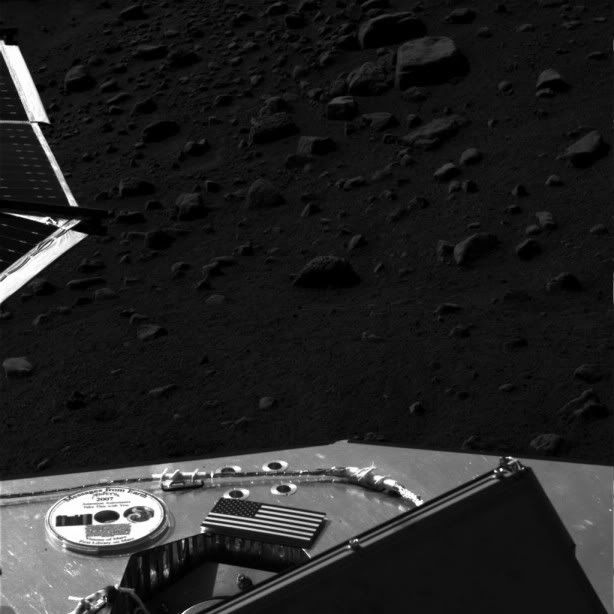
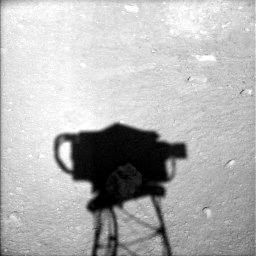
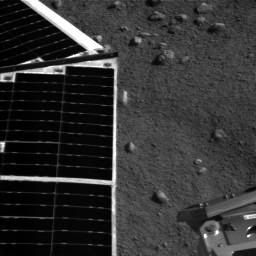
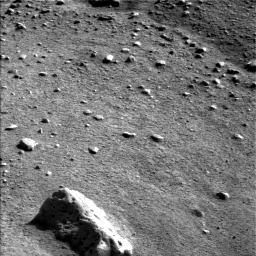
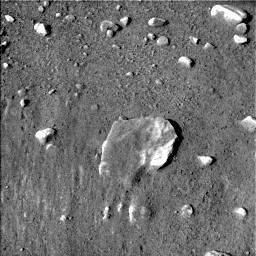
-------------------------------------------------------------------------------------------------------------------------------------------
Color images from Mars Phoenix
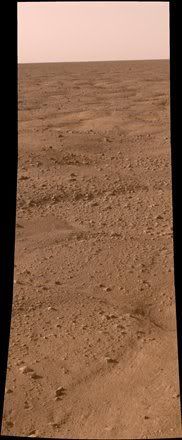
NASA this morning is releasing some color images from the MarsPhoenix Lander, which touched down lsat night on the planet's arcticnorthern plains. You can read about the spacecraft's dramatic arrivalin Todd Halvorson's post below, including coverage from the post-landing news conference overnight at the Jet Propulsion Laboratory.Also, you click on any of the pictures in this post or here to see a gallery of the Mars Phoenix Lander images released thus far.
Stay tuned here to The Flame Trench for live updates. If you click here or on the NASA TV viewerat the top of this page, you can watch live interviews with members ofthe Mars Phoenix team until around 10 a.m. Then, at 2 p.m., you canwatch the day after landing news conference. We expect to see some evenmore incredible photographs from Phoenix and an update on its statusthen.
[ 本帖最后由 kl90 于 28-5-2008 01:35 AM 编辑 ] |
|
|
|
|
|
|
|
|
|
|
|
 发表于 28-5-2008 01:24 AM
|
显示全部楼层
发表于 28-5-2008 01:24 AM
|
显示全部楼层
Incredible shot of Phoenix and parachute
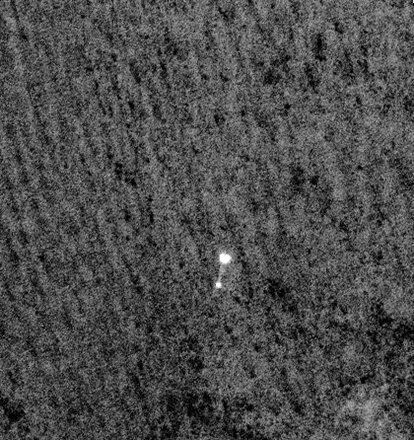
NASA is conducting a news conference this hour, but has just released this image of the Mars Phoenix Lander in the final moments of its descent to the surface. The picture was taken by Mars Reconnaissance Orbiter as it flew over the landing site during the entry, descent and landing last night. Click the picture to see a larger version.
This picture is expected to be enhanced later. NASA also expects to have more detailed, broader-view pictures of the Martian landscape surrounding the lander over the next few days. For now, three color images have been made available. Dozens of black and white engineering pictures are available. More are being beamed down with each data-relay opportunity.
The spacecraft is in good health and the team is working through its checklist to get Phoenix ready for science operations. |
|
|
|
|
|
|
|
|
|
|
|

楼主 |
发表于 28-5-2008 01:46 PM
|
显示全部楼层
"凤凰"号火星探测器因故障无法打开机械臂
http://news.xinhuanet.com/tech/2008-05/28/content_8268276.htm
美国国家宇航局下属的喷气推进实验室宣布,由于“火星勘测轨道器(MRO)”出现“临时故障”,阻碍了“凤凰”号上机械臂的展开。
该实验室发言人指出,由于计算机程序出现差错,“火星勘测轨道器”突然关闭了装备的高频信号发射机,导致地面控制人员无法通过其向“凤凰”号发射指令。不过,专家们同时强调,这并不是一个“无法克服的问题”。
喷气推进实验室“凤凰”号计划负责人福克·李(音译)认为,有可能是宇宙射线导致“火星勘测轨道器”意外切断了地球与“凤凰”号间的通讯联系。目前,一支专家小组已开始着手解决这一问题。
按照原先的计划,“火星勘测轨道器”会将接收自地球的指令转发给“凤凰”号,而后者获取的数据将通过另外一颗火星人造卫星--“奥德赛”轨道探测器--传回地球。福克·李指出,在必要的情况下,“奥德赛”将全面承担起“凤凰”号与地球控制中心之间的双向联系工作。
“凤凰”号于5月26日成功降落在火星北极地区。与“勇气”号和“机遇”号火星车不同的是,“凤凰”号并不会四处移动,而是将停留在原地进行挖掘--其配备有一条长度为2.3米的机械臂,可在火星表面挖出一个深度为60厘米的取样坑。
作为“凤凰”号上主要探测设备的机械臂可通过一种锄耕机动作,将松软区域的表层清除干净,让冰层裸露在外。然后用铲子前端的刀片切下一小片冰,不过真正挖掘冰样本时铲子后面需要有一个小钻。这个弹簧加压钻利用弹簧的压力,在地面上弹跳、旋转、摩擦冰土层。腕关节运动促使松动的冰样本进入小室,以进行分析实验。机械臂底部还有平土铲,它能将没用的物质清除掉,以便继续切割冰层。
正是因为机械臂所发挥的关键性作用,一旦其无法顺利打开,将会导致“凤凰”号的探测活动以失败告终。
“火星勘测轨道飞行器”于2005年8月12日发射升空,2006年3月10日顺利进入环绕火星的轨道。其净重为1031公斤,另外还携带1149公斤的燃料储备。两个面积分别为20平方米的太阳能电池板发电功率为2000瓦。一个直径为3米的抛物线型电线来保障远距离太空通信和向地面以每秒0.5至4兆的速度传输数据资料。“火星勘测轨道飞行器”探测项目总造价为7.2亿美元,其中探测器的本身造价为4.5亿美元。(作者:刘文国 田苗)
------------------------------------------------------------------------------------------------------
無線電出問題 鳳凰號火星探測任務稍遇延誤
http://tw.news.yahoo.com/article/url/d/a/080528/19/103qx.html
(法新社華盛頓二十七日電) 美國國家航空暨太空總署今天說,「鳳凰號」火星探測器為尋找維持生命的環境降落這顆紅色星球兩天之後,鳳凰號與地球之間的通訊小故障造成作業延誤。
加州巴沙迪納太空總署噴射推進實驗室的火星探索計畫負責人李富(音譯)說,一個「瞬間事件」破壞鳳凰號與火星偵測太空船之間的超高頻無線電傳輸,延後了鳳凰號與地球之間的資料與指令傳送。
這個問題迫使鳳凰號延後展開二點三五公尺長、用來挖掘火星北極含冰土壤以蒐集樣本的鋤耕機式手臂。
李富說,火星偵測太空船的無線電,可能遭到高速宇宙射線粒子碰撞導致故障,他說,這種情況過去從未發生過。
他說,太空總署的科學家已在積極修復這個故障。
李富強調,問題不在鳳凰號,「我們確定這是火星偵測太空船的問題...鳳凰號非常良好」。
雖然故障事件延後下令鳳凰號要展開什麼任務的指令傳送,但李富說,這項為期三個月、調查火星永凍層土壤是否有可居住環境的任務沒有受到影響,因為另一艘太空探測器「奧德賽號」可作為通訊支援。
太空總署官員說,與此同時,另一個可能讓機器手臂無法展開的小問題也已解決。
洛克希德馬丁公司的發言人奈皮爾今天稍早告訴法新社:「鳳凰號表現非常好,超乎我們預期,目前它狀態絕佳。」
他說,「我們希望」在手臂展開、程式設定好準備行動之後,「在約一週內的某個時間,開始挖掘火星土壤」。 |
|
|
|
|
|
|
|
|
|
|
|

楼主 |
发表于 28-5-2008 01:47 PM
|
显示全部楼层
太空探索》鳳凰號帶來地球人時光膠囊 留給火星人開啟
http://tw.news.yahoo.com/article/url/d/a/080527/17/101cu.html
美國太空總署(NASA)的火星探測器「鳳凰號」成功降落火星北極,將展開極地探測任務。除了這些科學研究工作,鳳凰號其實還攜帶了一批地球人的時光膠囊,要留給未來移居火星的人類開啟。
「鳳凰號」周日(台北時間26日上午)降落火星北極後度過的第一天都在整理裝備,並拍照了解整體環境,為接下來展開挖掘極地凍原土壤,分析生命跡象的最重要任務做準備。
三腳的鳳凰號降落火星北極後傳回的第一批照片是眼前佈滿小石頭的火星極地荒漠景象,周二它將展開8英尺長的機械手臂,進行一周的測試後才會挖掘第一把火星極地凍原土壤。NASA根據之前的探測照片研判,火星極地地表下約30公分深處可能有冰存在。
鳳凰號上除了精密的探測儀器外,還有一片留給未來移居火星的人類的DVD,這個數位時光膠囊內容包含今年3月過世的「2001:太空漫遊」作者、英國著名科幻作家克拉克,和著有「火星紀事」的美國科幻小說家雷布萊柏利的留言;還有一些以火星為主題的藝術作品,包括1936年飛俠戈頓影集海報,以及1938年讓地球人信以為真的歐森威爾斯廣播劇火星人入侵地球;以及成千上萬名火星愛好者的地球人名單。
這項火星時光膠囊計劃由美國行星協會負責,該組織已逝創辦人薩根曾說:「可能要等好幾百年後,才會有人,男人或女人,甚至是小孩登上火星找到這片碟片。當這些未來的火星人收到這片看來不起眼的碟片,他她將獲得的是我們這個世界給他們的訊息。」
鳳凰號在火星的任務預計進行92天,屆時鳳凰號配備的太陽能板將被火星惡劣天候揚起的塵土覆蓋而失去動力。 |
|
|
|
|
|
|
|
|
|
|
|

楼主 |
发表于 28-5-2008 01:50 PM
|
显示全部楼层
|
|
|
|
|
|
|
|
|
|
|
 发表于 29-5-2008 01:39 AM
|
显示全部楼层
发表于 29-5-2008 01:39 AM
|
显示全部楼层
Crew arrives; countdown to begin at 3 p.m.
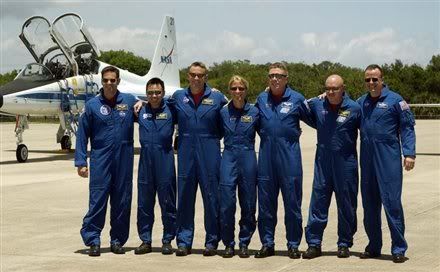
Discovery's crew arrived shortly after 12:15 p.m. and will begin preparing for Saturday's launch of STS-124 on a mission to the International Space Station.
Objective: Deliver the massive 32,500-pound Kibo laboratory and a 35-pound spare part to fix the space station toilet.
The countdown is expected to begin at 3 p.m. today.
Launch day weather is predicted to be 80 percent favorable, with a slight chance of thunderstorms.
Discovery will blast off at 5:02 p.m. EDT. Three spacewalks will be performed during the 14-day mission. STS-124 is the 123rd shuttle flight, the 26th flight to the space station and the 35th flight for Discovery. |
|
|
|
|
|
|
|
|
|
|
|
 发表于 30-5-2008 12:20 AM
|
显示全部楼层
发表于 30-5-2008 12:20 AM
|
显示全部楼层
http://www.floridatoday.com/apps/pbcs.dll/section?category=news02
MMT clears Discovery for flight
The Mission Management Team has given the go-ahead for launch of shuttle Discovery on Saturday.
No show-stopping technical issues have arisen during the Mission Management Team meeting, which began at 9 a.m.
Launch remains targeted for 5:02 p.m. EDT Saturday. Discovery's mission is to deliver a massive laboratory module to the International Space Station.
A spare part for the space station toilet arrived from Russia and was stowed on Discovery overnight. About 35 pounds of non-critical cargo was removed to make room for the gas/liquid separator.
Discovery's crew of seven arrived at KSC Wednesday and the launch countdown began.
Three spacewalks will be performed during the 14-day mission.
Also at 11 a.m. today, technicians were to begin loading liquid hydrogen and liquid oxygen into Discovery's power producing fuel cells.
----------------------------------------------------------------------------------------------------------
Toilet part stowed aboard Discovery
A spare part for the toilet on the International Space Station arrived from Russia and was stowed on Discovery overnight. About 35 pounds of non-critical cargo was removed to make room for the gas/liquid separator.
Discovery's crew of seven arrived at KSC and the launch countdown began Wednesday.
Today at 9 a.m., the Mission Management Team meets to give final approval for the 5:02 p.m. EDT launch Saturday. Watch The Flame Trench for coverage of a televised briefing after the MMT meeting. The briefing on NASA-TV will start no earlier than 11 a.m.
Discovery will be on a mission to deliver a massive Japanese laboratory to the International Space Station. Three spacewalks will be performed during the 14-day mission.
At 11 a.m. today, technicians will begin loading liquid hydrogen and liquid oxygen into Discovery's power producing fuel cells.
---------------------------------------------------------------------------------------------------------
Mars Phoenix robot arm ready to go
The Phoenix Mars Lander plans to unstow its robotic arm and could begin digging as early as next week after a communications glitch delayed progress earlier this week.
The glitch happened when the Mars Reconnaissance Orbiter shut off radio transmission with Phoenix for an unknown reason on Tuesday morning. NASA officials said they have switched primary communications with Phoenix to another orbiter, Odyssey, until they can determine what went wrong.
“This is a contingency we've always planned for,” said Barry Goldstein, the Phoenix project manager at NASA's Jet Propulsion Laboratory in Pasadena, Calif.
Glitch aside, the spacecraft is in excellent health, Goldstein said.
The nearly 8-foot robotic arm is key to the Phoenix's mission. The arm's goal is to dig beneath the surface and deliver samples of soil and ice to an on-board chemistry lab. Phoenix is looking for signs that the ice once melted and whether organic materials — the building blocks of life — are present.
Goldsten expects digging to begin early to mid next week.
Phoenix's science mission is expected to last three months, although the spacecraft could live into early 2009 depending on how much sunlight it receives to recharge its batteries. |
|
|
|
|
|
|
|
|
|
|
|
 发表于 30-5-2008 02:21 PM
|
显示全部楼层
发表于 30-5-2008 02:21 PM
|
显示全部楼层
http://www.floridatoday.com/apps/pbcs.dll/section?category=news02
Tiolet fix subject to glitch
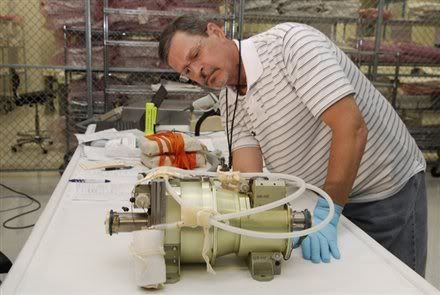
NASA managers hope - but have no proof - that a spare toilet part going up on Discovery Saturday is free of the same defect that caused two spares to fail on the International Space Station.
The three crewmen at the space station now spend an hour or more each day manually flushing their only toilet.
"Every three or four flushes it requires a manual procedure to go in and actually flush some additional water," deputy space station manager Kirk Shireman said at a Thursday briefing. "It takes about 10 minutes, and it takes two crew members. So it's quite inconvenient as you might imagine. ... You'd do it if that was your only option."
After the failure of an original compressor that worked for many years, both spare gas/liquid separators failed immediately.
A replacement part was flown to Kennedy Space Center from Russia and stowed on Discovery early Thursday. However, the dependability of the toilet part remains suspect. Though the part flying up on Discovery Saturday is from a different manufacturing lot, NASA managers have not tested the Russian part to make sure it doesn't have the same defect.
When Discovery arrives with the Japanese Kibo science module in its cargo bay, the ten members of the space station and shuttle crews will use the shuttle toilet. The cosmonauts likely will install the new toilet pump as soon as possible.
"Our expectation is it would be early in the (mission) timeline," said Shireman.
The toilet normally collects urine and pumps it into a tank on one of the Progress cargo modules, where it burns up when the unmanned container re-enters the atmosphere. Without a properly working toilet, NASA officials fear that urine droplets could escape, providing food for bacteria and damaging electrical systems.
"Urine is very corrosive," said Shireman.
Discovery is also bringing up several cases of potty bags that could be used by the crew in a worst-case scenario.
---------------------------------------------------------------------------------------------------------------
See our 1st live launch broadcast Saturday
Three veteran NASA astronauts.
The only reporter to cover every U.S. human space flight from American soil.
An engineer who led the team that prepared the Japanese Kibo lab for launch Saturday aboard Discovery.
And the longtime chief of the crew that helps astronauts board shuttles at the launch pad.
Those are among the guests who will appear on floridatoday.com's live broadcast of the countdown and launch of the space shuttle Discovery on Saturday afternoon.
The live broadcast will begin at noon, featuring live news reports from our space team and live interviews with special guests as well as the continuous video feed from NASA TV of the astronauts suiting up, heading for the launch pad, and blasting off from the Kennedy Space Center.
And, of course, you'll also find the continuous countdown status updates and other news throughout Saturday's launch and the STS-124 mission.
If you have questions you'd like our space team to answer during the broadcast or here in the blog during Saturday's launch coverage, email them to jkelly@floridatoday.com before Saturday morning. We'll answer as many as possible.
Meanwhile, also check out our interactive graphic of the Japanese Kibo science complex.
----------------------------------------------------------------------------------------------------------
Mars lander robot arm checking out OK
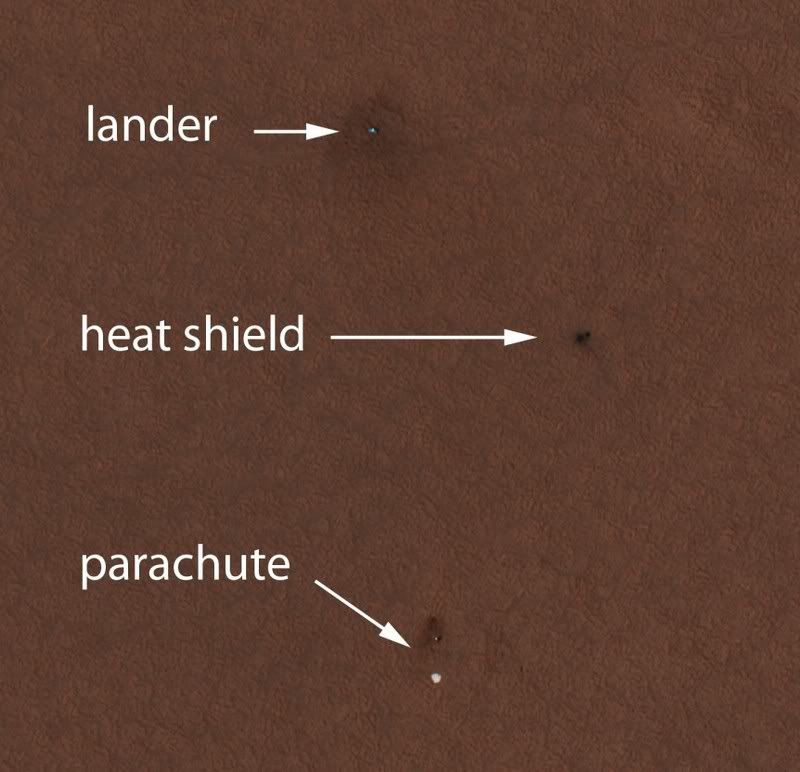
The robotic arm that will deliver soil and ice samples to the Phoenix Mars Lander’s science instruments for analysis is unstowed and in great shape, NASA said Thursday.
But the 8-foot arm will undergo days of tests before digging and delivering the first sample for analysis.
The arm, cooped up for 14 months prior to and during the spacecraft’s 422-million mile trek from Earth, has now used all four of its joints to move and free itself of protective restraints.
The arm has two shoulder joints, one elbow joint and one wrist joint to give it the mobility necessary to scoop material and precisely place it where needed, he said.
“All the joints are healthy and we’re raring to go,” said Matt Robinson, Robotic Arm flight software lead with the NASA’s Jet Propulsion Laboratory in Pasadena, Calif.
The arm will deliver soil and ice samples to the Lander¹s Thermal and Evolved-Gas Analyzer and the Microscopy, Electrochemistry and Conductivity Analyzer.
The science instruments will be checking for water and elements of life in materials scooped from the Martian northern arctic region. The gas analyzer will use eight tiny ovens to heat samples to determine their chemical makeup, and the electrochemistry instrument will use a wet chemistry lab and two microscopes to assess characteristics of the samples.
But several steps expected to take three or four days remain before the arm collects and delivers materials for actual testing some time next week, Robinson said.
-----------------------------------------------------------------------------------------------------------
Delta rocket launch moves to June 5
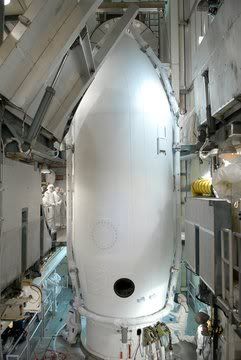
The planned launch next week of a NASA gamma-ray observatory on a Delta 2 rocket is being bumped back two days so mission managers can complete a launch vehicle readiness review.
The 13-story Delta 2 Heavy and its payload -- the Gamma-ray Large Area Space Telescope, or GLAST -- now is slated to blast off from complex 17 at Cape Canaveral Air Force Station during a launch window that will extend from 11:45 a.m. to 1:40 p.m. Thursday. The official launch date on the Eastern Range already is June 5 but NASA had hoped to move the launch up to June 3. Officials said the extra time is needed to close-out minor engineering issues.
The new observatory carries two sophisticated instruments that will enable scientists to detect gamma-rays. Invisable to the human eye, gamma-rays are the highest-energy form of light. The instruments will enable astrophysicists to shed new light on the nature of supermassive black holes, pulsars and cosmic rays, among other things. |
|
|
|
|
|
|
|
|
|
| |
 本周最热论坛帖子 本周最热论坛帖子
|